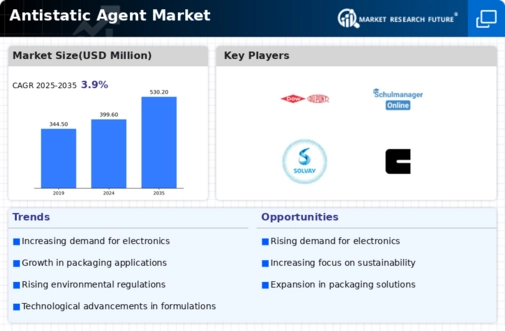Market Trends
Key Emerging Trends in the Antistatic Agent Market
The antistatic agent market, a crucial sector in the plastics, electronics, and packaging industries, is witnessing several notable trends that shape its current landscape. Understanding these market trends is essential for industry stakeholders to make informed decisions, stay competitive, and capitalize on emerging opportunities within this specialized market.
Growing Demand in Plastics Industry:
The plastics industry is experiencing a surge in demand for antistatic agents, driven by the need to mitigate static charges in plastic products. Increasing applications in packaging, automotive components, and consumer goods contribute to the growing demand for antistatic agents. Proliferation of Electronic Devices:
The rising usage of electronic devices, including smartphones, tablets, and wearable technology, fuels the demand for antistatic agents in electronic components and packaging. Antistatic agents play a crucial role in preventing static-related damage to sensitive electronic devices during manufacturing and handling. Shift towards Biodegradable Antistatic Agents:
Environmental concerns and a focus on sustainability are driving a trend towards biodegradable antistatic agents. Manufacturers are exploring and developing eco-friendly alternatives to meet regulatory requirements and address consumer preferences for greener products. Technological Advancements in Formulations:
Ongoing technological advancements in antistatic agent formulations contribute to market trends. Innovations in formulation techniques, including the development of long-lasting and more effective antistatic agents, influence product performance and market adoption. Focus on Smart Packaging:
The packaging industry is witnessing a trend towards smart packaging solutions, incorporating technologies such as RFID tags and sensors. Antistatic agents play a role in preventing static interference in smart packaging applications, influencing market dynamics within the packaging sector. Rise in Demand for Antistatic Films:
The demand for antistatic films is on the rise, especially in industries such as electronics, where preventing static buildup is critical during manufacturing and transportation. Antistatic films find applications in electronic packaging, protective covers, and other specialized uses, contributing to market growth. Increasing Application in Textiles:
Antistatic agents are finding expanded applications in the textile industry, particularly in the manufacturing of clothing and fabrics. The demand for antistatic textiles is driven by consumer preferences for comfortable and static-free clothing, influencing market trends in the textile sector. Stringent Regulations and Compliance:
Stringent regulations regarding the use of chemicals in various industries impact the antistatic agent market. Compliance with regulatory standards, such as REACH and RoHS, is becoming increasingly important for manufacturers, influencing product formulations and market access. Asia-Pacific Emerging as a Key Market:
The Asia-Pacific region is emerging as a key market for antistatic agents, driven by the growth of manufacturing activities in countries like China and India. Increasing industrialization, coupled with a growing electronics manufacturing sector, contributes to the regional demand for antistatic agents. Preference for Water-Based Antistatic Agents:
There is a growing preference for water-based antistatic agents over solvent-based counterparts. Water-based formulations are considered environmentally friendly and are gaining traction as industries seek sustainable and less volatile alternatives. Collaborations and Partnerships:
Collaborations and partnerships between antistatic agent manufacturers and end-user industries are becoming more prevalent. Working closely with industries such as electronics, packaging, and textiles allows manufacturers to tailor solutions to specific application requirements. Focus on Research and Development:
Companies in the antistatic agent market are placing a strong emphasis on research and development to stay competitive. Continued investment in R&D activities helps in the development of advanced formulations, keeping pace with industry demands and emerging trends.







Leave a Comment